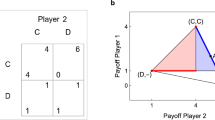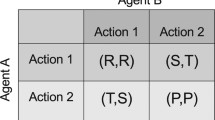Abstract
The bargaining process in economic and political issues such as the Economic Partnership Agreement (EPA) can present players with a situation wherein they engage in multiple games with their counterpart. Such a situation can be modeled as playing a Prisoner’s Dilemma (PD) game and a Coordination Game (CG) simultaneously and repeatedly with the counterpart. Referring to the equilibrium prediction and prior experimental results, we experimentally compared the individual and mutual cooperation rates in the PD when the subjects repeatedly played only the PD game with the identical counterpart (treatment G D) and when they repeatedly and simultaneously played the PD and the CG with the identical counterpart in each round (treatment G DC). First, we found that the individual cooperation rate was higher in the G D treatment than in the G DC treatment. Second, the mutual cooperation rate was higher in the G DC treatment than in the G D treatment in the second half rounds. Thus, playing the CG initially reduced cooperation in the PD but increased mutual cooperation in the PD in the later rounds. The first result could be attributed to the subjects’ facing a more complicated situation in the G DC treatment than the G D treatment. In contrast, the second result could be attributed to the subjects’ tendency to offer similar choices between the games in the G DC treatment.
Similar content being viewed by others
References
Ahn, T. K., E. Ostrom, D. Schmidt, R. Shupp and J. Walker (2001) “Cooperation in PD games: Fear, greed, and histroy of play,” Public Choice 106: 137–155.
Bernheim, B. D. and M. D. Whinston (1990) “Multimarket Contact and Collusive Behavior,” Rand Journal of Economics 21: 1–26.
Dal Bo, P. (2005) “Cooperation under the Shadow of the Future: Experimental Evidence from Infinitely Repeated Games,” American Economic Review 95: 1591–1604.
Feinberg, R. M. and R. Sherman (1988) “Mutual Forbearance under Experimental Conditions,” Southern Economic Journal 54: 985–993.
Fischbacher, U. (2007) “z-Tree: Zurich Toolbox for Ready-made Economic Experiments,” Experimental Economics 10: 171–178.
Knez, M. and C. Camerer (2000) “Increasing Cooperation in Prisoner’s Dilemmas by Establishing a Precedent of Efficiency in Coordination Games.” Organizational Behavior & Human Decision Processes 82: 194–216.
Ogawa, K., T. Kawamura, T. Kikutani and Sobei H. Oda (2007) “The successful strategy for mutual cooperation in the experimental multi-game contact,” Kyoto University Working Paper Series No. 91.
Phillips, O. R. and C. F. Mason (1992), “Mutual forbearance in experimental conglomerate markets,” Rand Journal of Economics 23: 395–414.
Phillips, O. R. and Mason, C. F. (2001) “Collusion in Horizontally Connected Markets: Multimarket Producers as Conduits for Learning,” in B. Silverman (ed.) Multimarket Organization and Multimarket Strategy pp. 205–227.
Sebenius, J. K. (1983) “Negotiation Arithmetic: Adding and Subtracting Issues and Parties,” International Organization 37: 281–316.
Spagnolo, G. (1999a) “On Interdependent Supergames: Multimarket Contact, Concavity and Collusion,” Journal of Economic Theory 89: 127–139.
— G. (1999b) “Social Relations and Cooperation in Organizations,” Journal of Economic Behavior and Organization 38: 1–25.
Author information
Authors and Affiliations
Corresponding author
About this article
Cite this article
Kawamura, T., Ogawa, K., Kikutani, T. et al. Is Cooperation Stimulated in a Prisoner’s Dilemma by Establishing an Efficient Outcome in a Simultaneously Played Coordination Game?: An Experimental Analysis. Evolut Inst Econ Rev 8, 279–295 (2012). https://doi.org/10.14441/eier.8.279
Published:
Issue Date:
DOI: https://doi.org/10.14441/eier.8.279




